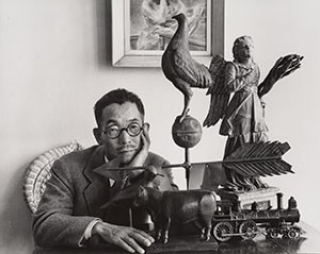Born 1889, Okayama, Japan
Died 1953, New York City
Yasuo Kuniyoshi emigrated to the US from Japan as a teenager in 1906. While studying at the Art Students League in New York, he made his debut at the First Annual Exhibition of the Society of Independent Artists in 1917. One of the most celebrated painters of the interwar period, he played an active role in many artists’ organizations, and his reputation served to protect him after the bombing of Pearl Harbor. Although reclassified as an “enemy alien” and subject to state scrutiny, he was able to avoid internment. In the years that followed, he contributed to the wartime propaganda effort against Japan. The Whitney Museum of American Art gave Kuniyoshi a retrospective in 1948, the first it devoted to a living artist.
In Kuniyoshi’s early canvases, self-contained, monumental figures rendered with an almost metallic sheen are isolated against expressionistic backgrounds. Contemporary critics often invoked the artist’s national origin to describe his singular fusion of styles and subjects, but his imaginative treatment of space and use of simplified, distorted forms testify to a deep engagement with American folk art. An avid collector of such works himself, Kuniyoshi was also close to Hamilton Easter Field, whose art colony in Ogunquit, Maine, was central to the explosion of interest in folk art and “Americana” during the 1920s. By adapting vernacular motifs, Kuniyoshi intervened in a broad effort to define an American artistic culture. The wartime atmosphere of suspicion and nationalism put his worldly combination of diverse influences and sources under considerable pressure.
The simplified handling of the child in Boy Stealing Fruit is influenced by early American portraits such as the well-known Baby in Red Chair from Abby Aldrich Rockefeller’s pioneering collection of folk art, while the view out the window is reminiscent of early Sienese landscape painting. Similarly, the instability of the table echoes the still lifes of Paul Cézanne, even as the fruit itself is depicted in the manner of vernacular American decoration. Combining these intersecting historical, geographic, and even generic traditions according to his unique vision, Kuniyoshi forged an expansive American aesthetic.
Jenevive Nykolak
Wolf, Tom. The Artistic Journey of Yasuo Kuniyoshi. Washington, DC: Smithsonian American Art Museum, 2015.
